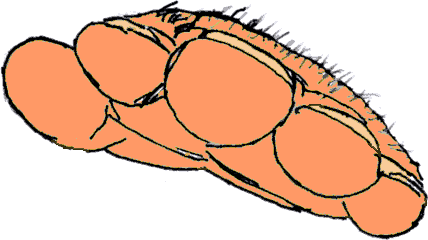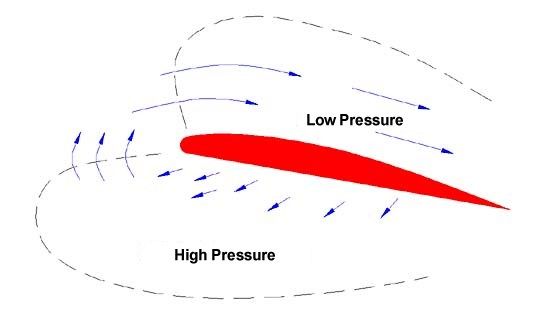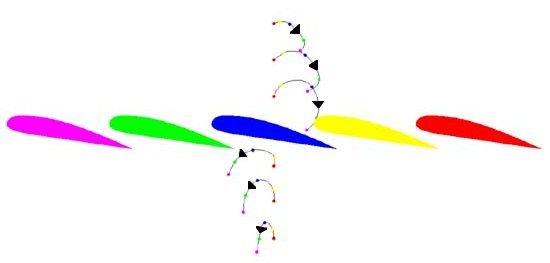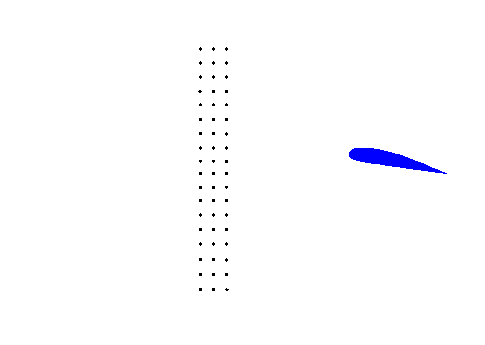 Few physical principles have ever been explained as poorly as themechanism of lift. By the time you finish reading this, you will understand the way thatwings work. But, you will probably have to forget just about everything you ever readbefore about the subject.
Few physical principles have ever been explained as poorly as themechanism of lift. By the time you finish reading this, you will understand the way thatwings work. But, you will probably have to forget just about everything you ever readbefore about the subject.
First of all, lift has nothing to do with the curve on top of the wing. Anyone who hasevery tried to carry a large sheet of plywood on a windy day knows that flat plates createplenty of lift. Even a ridiculous shape like this will work:

Don’t believe it? Just stick your hand out a car window at sixty miles an hour andtwist it up and down. Almost any shape will create some lift. The exact cross sectionsimply determines how efficiently it will do so and how it behaves at different angles ofairflow.
The next thing you need to forget is Bernoulli. At least for a while. Airplanes, birds,whatever, are not "sucked" up into the air except during tornadoes.
Airplanes stay up because the wings move air downwards. (Please read that again.) Aftera plane goes by, there is a lot of air closer to the ground than there was before. Thereaction to moving the weight of this air counteracts the pull of gravity. Blow up aballoon, point the neck down, and let it go. The air that was inside will now be closer tothe floor. The balloon goes the other way. Wings do the same thing except they move theair by deflecting it rather than by squeezing it out in a jet.
Below the wing
Airfoils, wings, barn doors, plywood sheets, hands sticking out of cars, all can createlift but only when the air is striking them at an angle (of attack). Stick your hand outin front of you and sweep it sideways while held at about a 30-degree angle. Imagine youare sweeping it through mashed potatoes. What are the potatoes doing? Piling up under itand being pushed ahead, of course. Air does the same thing. This pileup of air creates anarea of high pressure below and ahead of the wing. The air is also deflected downwards soit isn’t hard to see how the wing is pushed upwards. Moving air downwards is the wing’sprimary function.
The air under a lifting surface is also dragged slightly in the direction of travel,just like the mashed potatoes. The speed of this movement is subtracted from the airspeed.Thus, air is flowing slower beneath the bottom of the wing than the plane is moving.

Confused? Didn’t everything else you’ve ever read show the air moving from the front ofthe wing to the back? Go slow until this is clear. It’s the key understanding the wholething.
You have to keep your frame of reference in mind. If you were riding on a wingtip,you’d see air rushing from front to back both over and under the wing. But instead,imagine you are standing on a rooftop watching the plane go by. Further, imagine thatthere is a dust mote hanging in the still air … and that you have very good eyes. As thewing passes over it, the dust will move forward and down from its original position. Thenthe wing will have passed and the dust mote will just be hanging there again.
If the pilot maneuvered so that the wing passed over the dust mote at zero angle ofattack (and zero G), the bottom of the wing would not be displacing the air, and the dustmote then would not move.
In trying to understand lift, thinking about the movement of air particles relative tothe undisturbed air mass is more enlightening than contemplating the flow over the wing.
Above the wing
Since the wing is at an angle, its movement also tries to sweep out a space behind thetop. The inertia of the air that goes over the top of the wing tries to keep it moving ina straight line, while the pressure of the atmosphere tries to push it down towards thewing’s surface. The inertia prevents the atmospheric pressure from packing the space asfirmly as it would if the wing were standing still. The result is a low-pressure regionabove the wing. Air rushes from high- to low-pressure regions, from the high-pressure areaahead of and below the wing into the low-pressure space being swept out above and behindit.
The direction of this movement is toward the trailing edge of the wing, the samedirection as the airflow created by the wing’s motion. As a result, air flows faster overthe top of the wing than the plane is moving.
If you are standing on that rooftop, a dust mote hanging in the air will move quicklytowards the tail of the plane as the wing passes under it. It will also end up lower thanit was before the plane went by.
Circulation
We’ve seen that air is pushed forward under the wing, and accelerated backward over thewing. The combination of these two movements also causes the air ahead of the wing to moveupwards. This pattern is called circulation.

"Wait a minute!" you’re probably saying to yourself by now, "I know damnwell the air doesn’t flow around the wing that way!" Well, you’re right … but don’tgive up yet. Here is where it gets interesting.
Remember, when we are talking about circulation, we are not talking about flow over thewing. We are looking at the brief movement of the previously motionless air particles asthe wing passes by. No individual particle of air makes the whole trip shown above. Theplane passes and each particle of air is moved slightly as shown below. Then, the wing isgone.

These paths are actually a bit more complex than described above, but we’ll come backto that. Note that all particles, despite being deflected upwards ahead of the wing, endup lower than their initial position.
The innumerable particles in the real air mass are all bumping into each other, andeach is affected by the ones next to it. The whole system of motion is much like a wave inthe water.
If you’re still having trouble visualizing how the wing affects the air as it movesthrough it, perhaps the following animation will help:

See how the air above the wing is deflected down and aft, while the airbelow the wing is deflected down and forward?
Marine analogy
Imagine that you’re sitting in a small boat as a wave goes by. The wave has a clearlyidentifiable shape and organization that appears to race through the water. As it passeshowever, the boat goes up and down and back and forth but it ends up in essentially thesame place as it was before the wave passed. The water itself does the same thing … itdoesn’t actually move with the wave. At any instant, each part of the wave is composed ofdifferent water particles. The flow of energy that defines the shape of the wave istransferred from particle to particle, and each particle is disturbed only slightlycompared to the overall progress of the wave through the water.
The circulation of air around a wing is like a wave that moves with it, similar to thewake that moves along with a ship. There is a clearly organized pattern of movement butthe cast of individual particles that make it up is constantly changing as the disturbancemoves through the fluid.
So, what about the upward loops in the figure above? The acceleration of air to theright above the wing and to the left below it causes the air to rise for a considerabledistance ahead of the wing as gravity attempts to equalize the pressures. Air tries tomove from high to low pressure and, by the time the wing arrives, has established a prettygood upwash. Even the air directly below the wing is higher than it was before the planecame along. By the time the wing has passed however, all the air is lower than it wasbefore. This downward movement is the primary mechanism of lift.
Bernoulli again
So why does everyone keep prattling about a dead white male named Bernoulli? Well,Bernoulli figured out some very interesting things about what happens right at the pointwhere the air meets the wing. But this is only a small part of the story of lift.
The movement of air around a wing is a system. A crane is a system. It has a hook, acable, a winch, and an engine. Most of the popular discussions of wing lift are likearguing whether a crane does its lifting with the hook or the cable. When it comes tolift, Bernoulli is just the hook. It doesn’t make much sense unless you know about thecable, the winch, and the rest of it.
We’ve previously seen that, as a result of circulation, the air above the wing flowsbackward over the wing faster than the plane is moving, and the air below the wing flowsbackward over the wing slower than the plane is moving. So why is this difference in speedso important? Well, air has pressure, created by gravity. Release this pressure and itwill expand, like a spring. But it can only expand at a certain rate, much like the closeron an aluminum screen door. Open the door and release it for 1/4 second, and it will onlyclose half as far as if you let it go for 1/2 second.
When air moves quickly over a surface, it has less time to expand and press on thesurface than if it were moving slowly. The faster-moving air over the top of the wingtherefore doesn’t press down on the wing as hard as it would if the air had not beenaccelerated by the circulation process.
Keep in mind, however, that THIS IS NOT SUCTION! The air above the wing is stillpressing down on the wing. It is just not pressing as hard. "Suction" is not aforce. It is just a way of saying that the pressure at one place is less than it issomewhere else. Inside that suction cup stuck to your window, there is air pressure …just less air pressure than exists outside the suction cup.
The air below the wing is moving slower than it would if the wing were rotated to moveedgewise and stop the circulation process. Therefore, it is pressing harder on the wing.On top, the air is moving faster over the surface and has less pressure. The wing ispushed upwards by the difference in pressure between the top and the bottom. This isusually called "lift" but calling it that is just as silly as calling a hook a"crane."
Where is lift created: top or bottom?
The difference between ambient pressure and the pressure on top of a wing is generallygreater than the difference on the bottom. Many writers have said that this means thatlift is created primarily on top of the wing. That is also silly. The pressure on one sideof the wing is meaningless except in reference to the pressure on the other. The pressureson the two sides are linked by circulation and, without that circulation, there can be nodifference in pressure.
You may have figured out that, since the primary function of a wing is to move airdownwards, the circulation created upwash is reducing the amount of lift. This is true. Aninteresting thing happens when the wing gets close the ground. The runway prevents airfrom moving upward and the forward, and therefore increases the pressure beneath the wing.The result is increased lift and decreased induced drag. Can you spell "G-R-O-U-N-D E-F-F-E-C-T"?
In order to save postage for a least a couple of letter-to-the-editor writers, I shoulddiscuss one special case of wing flow. If a Clark Y-style wing with a flat underside isoperating at an angle of attack where the bottom is exactly aligned with the airflow,there will be very little disturbance of air below the wing. The increase in air pressurebelow the wing will only be that caused the intrusion of a thick object. The top of thewing, its aft portion being lower than the leading edge, will still be sweeping out aspace into which air will rush creating an acceleration of air over the top and a modestamount of circulation. Although the air pressure below the wing will be very close toambient, there will still be a pressure difference between top and bottom.
This is the situation closest to that usually described in science textbooks, and onein which very little is happening below the wing. Modestly powered aircraft seldom operatelike this, and then only near maximum speed since minimum lift is being produced. The wingin this situation actually has a slight angle of attack due to its asymmetrical shape.Zero angle of attack is the angle where there is no final displacement of air up or down.For the classic flat-bottom wing shape, that would be with the trailing edge slightlyhigher than the forward edge of the bottom.
The boundary layer
If Bernoulli is the hook, than the ring that the hook goes into is another mysteriousconcept called the boundary layer. You’ve probably noticed that the wind close to theground is not as strong as it is higher up. The friction of the ground slows it down. Evena highly polished wing does the same thing. The speed of the airflow above and below thewing becomes less and less closer to the surface. The thin layer of air that actuallytouches the wing isn’t moving over the surface at all, but is dragged along by the winglike a sheer negligee. The thicker region around the wing where the speed of the airflowis slowed by surface friction is known as the boundary layer.
The pressures in the motionless part of the boundary layer right at the wing’s surfacevary according to the energy transmitted to them by the moving air above. These pressuredifferences push the wing upwards. The amount of energy (pressure) transmitted variesaccording to the speed of the air in the flow just above. The circulation process controlsthe speed of the overall flow. The energy for the circulation comes from the aircraft’sengine or, in the case of a glider, from gravity.
It’s all one interconnected system. Unless the overall result of that system is for airto end up lower than it was before the plane flew by, there will be no lift. Wings moveair downward, and react by being pushed upward. That’s what makes lift. All the rest isjust interesting details.



































With all due respect, I am intrigued to know how you are qualified to make the assertions in this article. I am aware that there is, and always has been, a lot of speculation on this subject. I’d like to pass this article on but before doing so I’d be grateful if you’d provide me with a basis for authentication of the content.
FYI I am a glider pilot.
Best wishes
Ian